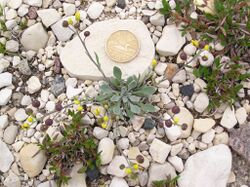Biology:Physaria arctica
| Physaria arctica | |
|---|---|

| |
| Scientific classification | |
| Kingdom: | Plantae |
| Clade: | Tracheophytes |
| Clade: | Angiosperms |
| Clade: | Eudicots |
| Clade: | Rosids |
| Order: | Brassicales |
| Family: | Brassicaceae |
| Genus: | Physaria |
| Species: | P. arctica
|
| Binomial name | |
| Physaria arctica (Wormsk. ex Hornem.) O'Kane & Al-Shehbaz
| |
Physaria arctica is a perennial flowering herb in the family Brassicaceae, known by the common name arctic bladderpod.[1]
Description
Plants are 6–12 cm high[2] with a short taproot and woody stem-base. Basal leaves, 2–6 cm and arranged in a rosette[3] predominate, and are obovate to oblanceolate, while cauline leaves, sessile or shortly petiolate, are oblanceolate or lingulate and 0.5-1.5 cm.[4] Inflorescences are loosely racemose, with flower stalks ascending or erect and 5–20 mm. There are 3-8 radially symmetrical flowers per inflorescence,[3] and the petals are spaulate, 5-6mm, with blades that narrow gradually to the claw.[4]
Habitat
Physaria arctica grows in sand and gravel from calcareous bedrock, river bars and terraces, cliff ledges, scree and talus slopes.[4]
References
- ↑ "Physaria arctica (Wormsk. ex Hornem.) O'Kane & Al-Shehbaz". https://www.itis.gov/servlet/SingleRpt/SingleRpt?search_topic=TSN&search_value=823087. Retrieved 17 June 2016.
- ↑ Aiken, S.G.. "Flora of the Canadian Arctic Archipelago: Lesquerella arctica (Wormskjold. ex Hornem.) S. Watson". Canadian Museum of Nature. http://nature.ca/aaflora/data/www/balear.htm. Retrieved 17 June 2016.
- ↑ 3.0 3.1 Douglas, G.W., D.V. Meidinger, and J. Pojar, ed (1999). Illustrated Flora of British Columbia. Volume 4: Dicotyledons (Orobanchaceae Through Rubiaceae). Victoria: B.C. Ministry of Environment, Lands & Parks and B.C. Ministry of Forests.
- ↑ 4.0 4.1 4.2 "Physaria arctica". http://www.efloras.org/florataxon.aspx?flora_id=1&taxon_id=250095107. Retrieved 17 June 2016.
Wikidata ☰ Q17245742 entry
 |

